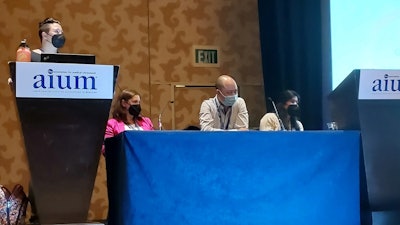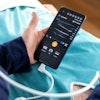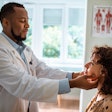
SAN DIEGO - Despite medical students gradually returning to in-person learning, some aspects of virtual learning that were adopted during the COVID-19 pandemic may be here to stay, according to experts at a March 12 panel at the 2022 American Institute of Ultrasound in Medicine (AIUM) annual meeting.
Panelists shared their experiences teaching while maintaining safe distances throughout the COVID-19 pandemic. They said that while there is still value in in-person learning, the pandemic created opportunities for ultrasound educators to use more resources for virtual teaching while providing students with experience in practical skills.
"Hopefully, some of the things we've learned this year, we can take back with us such as assessment uses and using these virtual-based sources, and test their value online," said panel moderator Dr. Creagh Boulger from Ohio State University.
While virtual teaching may not have been in the cards for many educators before the pandemic, institutions were forced to quickly pivot to this model to provide education during trying times. Boulger said the pandemic created an enhanced sense of community when it came to providing education and patient care.
 Panelists discuss ways they have had to tailor their education models for virtual learning, as well as why some virtual learning components may become permanent for ultrasound curricula. From left to right: Dr. Creagh Boulger, Dr. Cristiana Baloescu, Dr. Yale Tung Chen, and Dr. Shweta Bhatt.
Panelists discuss ways they have had to tailor their education models for virtual learning, as well as why some virtual learning components may become permanent for ultrasound curricula. From left to right: Dr. Creagh Boulger, Dr. Cristiana Baloescu, Dr. Yale Tung Chen, and Dr. Shweta Bhatt.However, virtual teaching has proven it can be used for more than just education from a safe distance when "used smartly" and with diverse presenters. Previous studies have suggested such teaching methods are effective. Panelists also said that in some ways, virtual tools have made teaching easier.
Dr. Yale Tung Chen from La Paz University Hospital in Madrid said he doesn't give in-person lectures to his students these days since the pandemic hit.
"I always send the students, residents, or fellows to do the teaching part. I don't give them my material because there's so many great resources out there," he said. "They have to read core readings and then I teach the practical parts and they show me what they learned."
Another advantage researchers said comes with virtual learning is obtaining continuing medical education (CME) credits without having to travel long distances.
"They don't necessarily have to go to a meeting if they don't want to," said Dr. Shweta Bhatt from the Mayo Clinic in Jacksonville, FL. "They [students] can stay home and get those credits."
Bhatt also said the pandemic created a situation where students interact in real time with faculty online rather than wait for feedback.
"With Zoom, wherever faculty is, they have no way out," she said. "They are expected to log in, send a Zoom link to residents, and read alongside them, so it's as good as a live readout. I think this is a useful thing that will probably remain."
AIUM panelists said that virtual learning cannot replace some of the more practical skill opportunities, however, such as bedside learning. Along with that, they said in-person learning promotes the social aspect of medical work.
"It gives them [students] the chance to network and interact, which are key," said Dr. Cristiana Baloescu from Yale University.




















